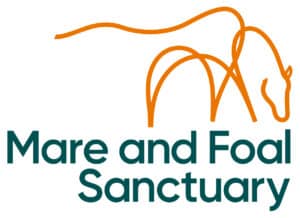Poisonous plants
Watch out for poisonous plants in or near where your horse is grazing. Regular field management and quick action can prevent tragedies if you know what to look out for.
Ragwort (jacobaea vulgaris or senecio jacobea)
Ragwort plants are biennial, which means they take two years to fully grow and flower. They start off as small green cabbage like rosettes and can eventually reach one-metre tall. The clusters of small yellow flowers will bloom between July and October.
Why is it dangerous?
The entire plant – flowers, leaves, root and stem – are poisonous. It is bitter tasting and not usually eaten by horses who have access to sufficient grazing. The concern lies when pastures are over grazed and the horses do not have acceptable forage. If this happens the horses may be more inclined to eat it. Plants or leaves that have been pulled out and left to dry are still poisonous and can be even more dangerous as they become more palatable, less bitter and more likely to be eaten.
Ragwort contains pyrrolizidine alkaloids which cause liver damage resulting in liver disease and death. There is no known cure once poisoned. If the horse ingests it in small doses the damage will have the same cumulative effect as eating it in a large amount. Due to the type of damage in the liver cells, the liver will not be able to regenerate.
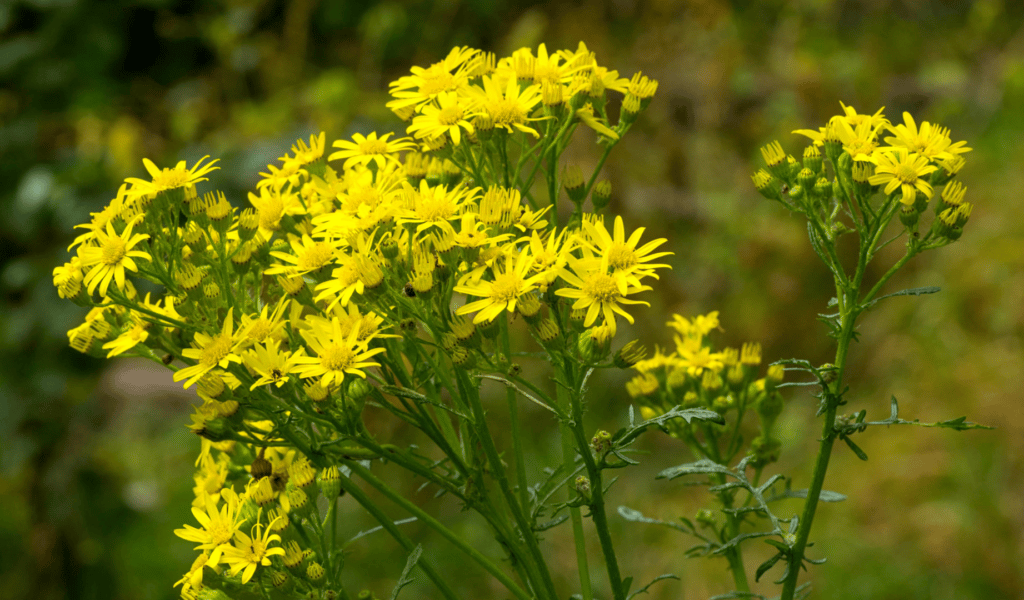
What are the signs of ragwort poisoning?
- Colic
- Loss of appetite
- Depression
- Diarrhoea
- Skin photosensitisation
- Weight loss
- Yawning
- Head pressing
What are the signs of liver damage?
- Yellow mucous membranes
- Lack of coordination
- Depression
- Jaundice
What treatment options are there?
Treatment is rarely successful but if liver failure has not developed, then supportive care can be given with vet’s advice.
How can I keep ragwort under control or prevent poisoning?
Once a plant flowers, it will produce thousands of seeds which are very easily spread in the wind. The best method of control is by pulling the entire plant from the root before it blooms. To remove ragwort, gloves should be worn as it is harmful to humans too as the toxins can be absorbed by the skin and cause liver damage. With the use of a rag fork, pull out as much of the plant and root as possible and make sure there aren’t any leaves left behind.
Seeds can lie dormant for as long as 20 years, so even after removal, it’s a good idea to keep checking that there aren’t any new plants growing. You must dispose of ragwort properly by burning.
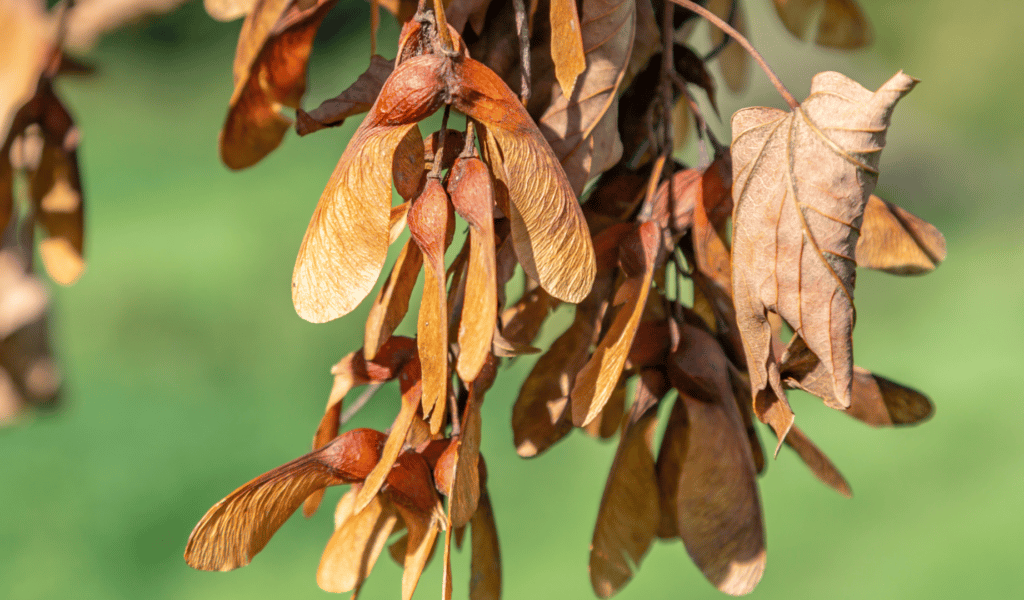
Sycamore (acer pseudoplata)
Sycamore is a tree that can grow to 35 metres high and can live around 400 years. The bark is dark pink-grey, smooth when young and develops cracks with age. The leaves are hairy underside, have 5 lobes and can grow from seven to 16 centimetres wide. Younger leaves are redder in colour. The flowers are small green-yellow and hang like a triangle pointing downwards. The seeds are called samaras, which resemble a helicopter like double seed and form a triangular shape. The narrow
angle distinguishes from the harmless field maple.
Why is it dangerous?
The seeds and seedlings contain high levels of something called hypoglycin A which prevents energy from being produced in the muscle cells.
Ingestion of the seeds, seedlings and possibly leaves can cause a fatal disease called atypical myopathy. It is unknown how much a horse must ingest to become ill. It is much more common in autumn or in bad weather. Eating sycamore causes muscle damage, especially muscles used for horses to stand, breathing and heart problems.
Atypical myopathy is diagnosed by a vet through recent grazing history and a clinical exam. A blood test can be performed, but more often, once signs appear, the process is irreversible. It is fatal to around 75% of horses affected.
What are the signs of atypical myopathy?
- Dull
- Weak
- Trembling
- Stiffness
- Difficulty lifting head
- Lethargy
- Muscle tremors
- Red or brown urine
- Fast and laboured breathing
What treatment options are there?
Diagnosis may take a few days, but vets will usually start treatment immediately if atypical myopia is suspected. Admission to a hospital for specialised care may be necessary. If the horse survives the first few days, they will usually make a full recovery, although it may still take months.
How can I keep sycamore under control or prevent poisoning?
Avoid using a paddock near sycamore altogether during autumn. If it’s not possible to move
paddocks, then fencing off the area with sycamore seeds or seedlings is the best solution. Seeds will still need to be removed, which can be done by hand picking, blowing the seeds into a pile or raking them to make it safe after they have all fallen off the trees. You must pick any seedlings by hand from the root.
Foxglove (digitalis purpurea)
Foxglove normally grows in hedges, gardens and walkways. The plant has large green leaves and the bell-shaped flowers are dark pink and grow on a single spike. The flowers bloom between June and September. It can grow up to 1.5 metres tall and drops its seeds near the plant. The seeds do not scatter very far.
Why is it dangerous?
Ingesting the plant causes an increase of intracellular calcium in the heart cells. This affects the electrical conductivity in the heart which causes an irregular heart rate and rhythm and eventually death.
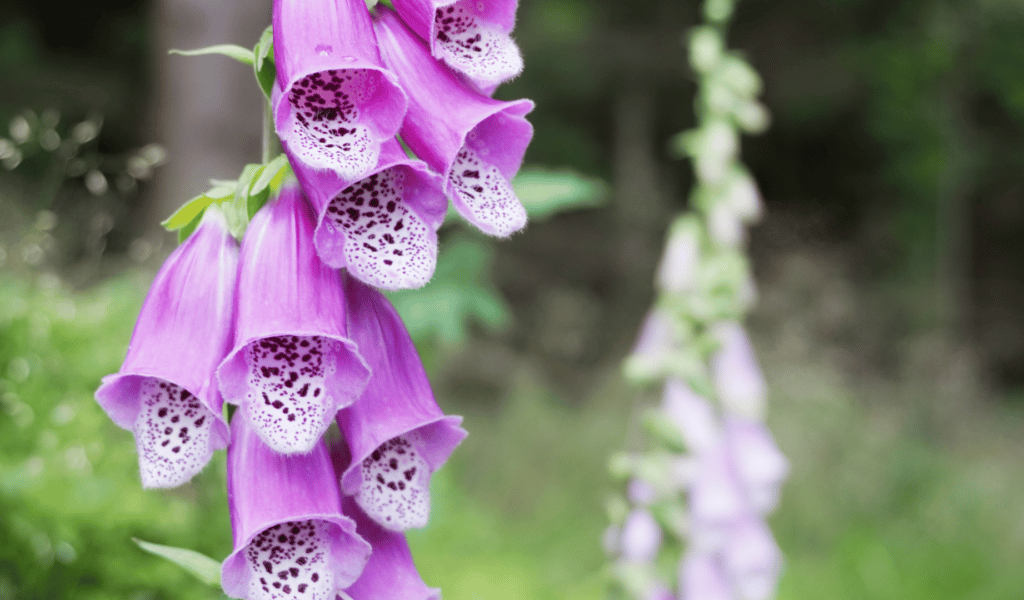
What are the signs of poisoning?
- Profound weakness, difficulty holding the head up
- Swelling of the head, neck, lips and eyes
- Convulsions
- Erratic heartbeat
- Terminal seizures often seen before death
What treatment options are there?
Options for treatment are very limited. Once ingested, unless actions are taken immediately, the chances of survival are not good. You must remove the horse from the environment and urgently call the vet. The vet may try using activated charcoal followed by mineral oil to clear the poison from the horse’s system.
How can I keep foxgloves under control or prevent poisoning?
The entire plant is toxic and can cause skin irritations to humans. You must wear gloves to remove and dispose of the plant. It can be easily pulled from the ground by hand or you can use a ragwort fork.
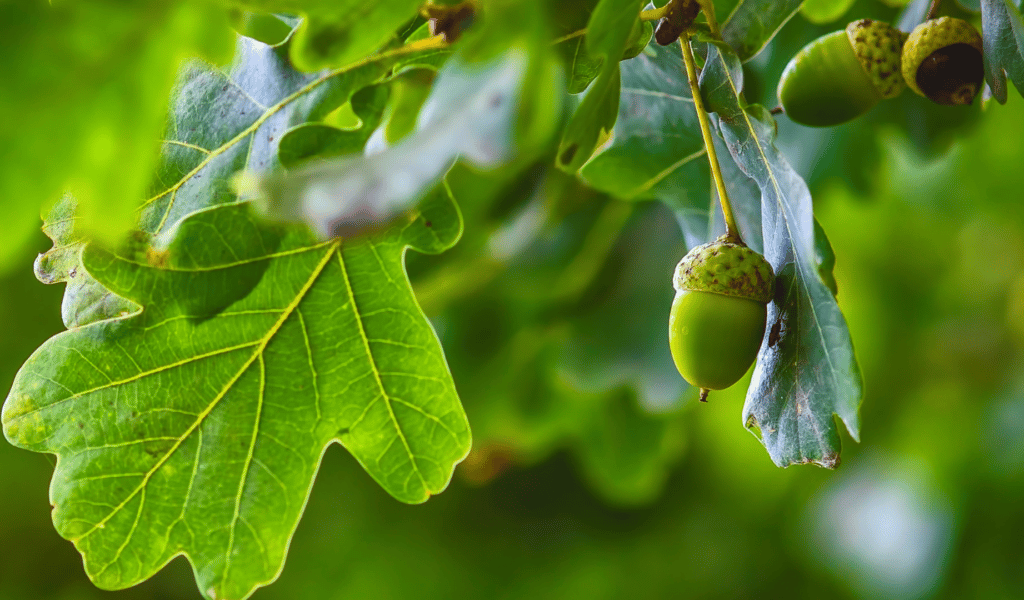
Oak (quercus)
Oak is a large deciduous tree common in the northern hemisphere. It grows up to 40 metres. The oak has four to five centimetre long deep-lobed leaves and produces a singular nut called an acorn which takes six to 18 months to mature.
Why is it dangerous?
Acorn poisoning is caused by the ingestion of large amounts of acorns, leaves, or branches. They contain tannic and gallic acids which can cause severe damage to the gastrointestinal system and kidney.
What are the signs of poisoning?
- Constipation
- Reduced appetite
- Colic
- Blood in the urine
- Kidney damage
- Dehydration
- Oedema in the legs (buildup of fluid)
What treatment options are there?
You must call the vet urgently. Although there is no cure, activated charcoal has been effective if given immediately after ingestion. The charcoal will absorb the toxins in the gut and eventually get excreted. As dehydration is a common sign, IV fluids can be given. This will help combat fluid loss from diarrhoea and prevent renal failure. In severe poisoning, the fluids may also help support the horse’s circulatory system and help prevent shock.
How can I keep oak trees and acorns under control or prevent poisoning?
The most effective way to prevent horses getting to the acorns is by fencing off the area around an oak tree during high winds and during September and October when acorns fall.
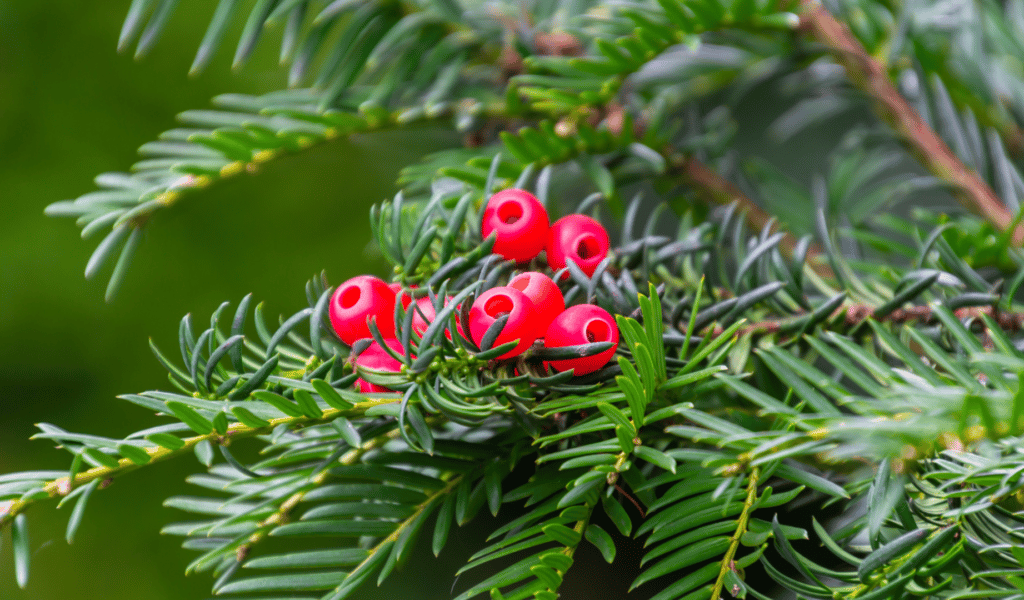
Yew (Taxus baccata)
Yew is an ornamental evergreen tree or shrub mostly found in hedges and cemeteries that can grow to 20 metres tall. The leaves are dark green and grow in two rows of needles along the twig. It bears a red fruit which takes six to nine months to mature.
Why is it dangerous?
All parts of the yew tree are extremely poisonous and ingesting even a small dose of taxine A or B toxins is lethal. As little as 170 to 225 grams of plant can kill a horse in five minutes. Signs are not often observed as horses die quickly after ingestion.
What are the signs of poisoning?
- Muscle trembling
- Incoordination
- Difficulty breathing
- Diarrhoea
- Convulsions
- Sudden death
What treatment options are there?
There is no treatment available.
How can I keep oak trees and acorns under control or prevent poisoning?
Prevent horses grazing where there is yew present.
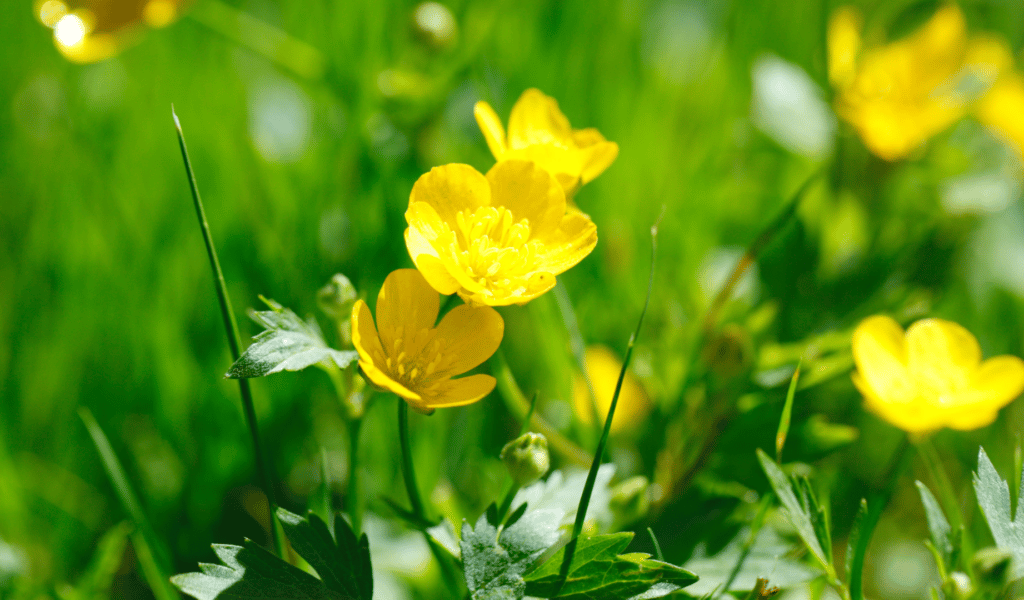
Buttercup (ranunculus acris)
Buttercup is a perennial plant that comes into bloom in the spring. Its yellow flowers continue through the summer. It has long runners and strong penetrating roots.
Why is it dangerous?
Buttercups contain ranunculin which can make a compound known as protoanemonin when the plant is damaged. This is especially problematic in wet conditions. It can cause irritation, swelling and blisters on horses’ lips, muzzle and lower limbs. Pale-coloured skin can be even more susceptible. If eaten in large quantities, buttercups can cause oral and gastric ulcers, colic and diarrhoea. Luckily, its acrid taste usually discourages horses from eating them.
What treatment options are there?
Removing access to the plant will allow the irritation to dissipate. If there are blisters visible, a vet should be contacted in case the horse needs antibiotics.
How can I keep buttercup under control or prevent poisoning?
Avoid overgrazing and sparse pasture where buttercup can grow more easily. Allowing paddocks to rest and spraying with a weed killer can help. Make sure to get the right advice from a professional who can suggest an appropriate spray to use that is safe for horses.
Hemlock (Conium maculatum)
Hemlock is a plant mostly found in hedgerows and fields. It has parsley-like leaves and a green hollow stem speckled with purple spots. It can grow two to three metres tall and has umbels of tiny white flowers. The root has a distinctive singular appendage.
Why is it dangerous?
Hemlock contains the poisonous compound called coniine. All parts of the plant are toxic, but as the plant matures, the amount reduces and becomes less potent. The most dangerous are the seeds and dried plant matter as they contain coniine in the largest concentration. Signs of poisoning will occur within an hour of ingestion.
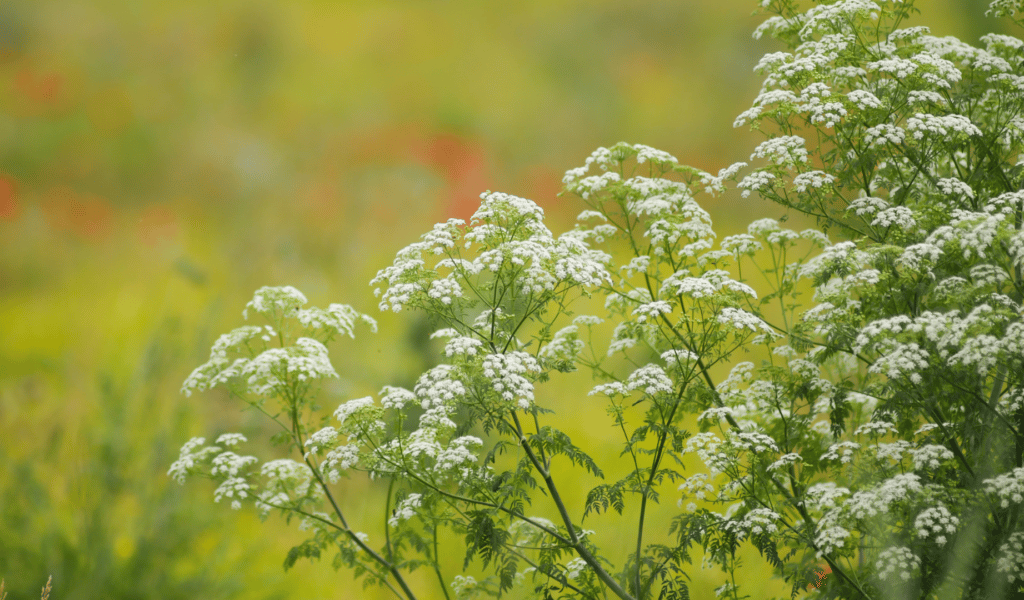
What are the signs of poisoning?
- Trembling
- Muscle weakness and incoordination
- Salivation
- Pupil dilation
- Weak heartbeat
- Prolapse of the third eyelid across the cornea
- Central nervous system depression
- Renal failure
- Death by respiratory failure due to paralysis of respiratory muscles
What treatment options are there?
There is no known cure. You can provide supportive care by removing the horse from the area, providing clean water and forage and closely monitoring them. The vet should be contacted in case IV fluids may be necessary.
How can I keep hemlock under control or prevent poisoning?
Hemlock can produce up to 40,000 seeds so it is essential to remove it before it blooms and spreads. New plants tend to emerge in November and March, so this is the best time to use a chemical spray. Mowing and pulling by hand are also effective but you must collect and dispose of any remnants. You should wear gloves as hemlock can cause skin dermatitis in humans.
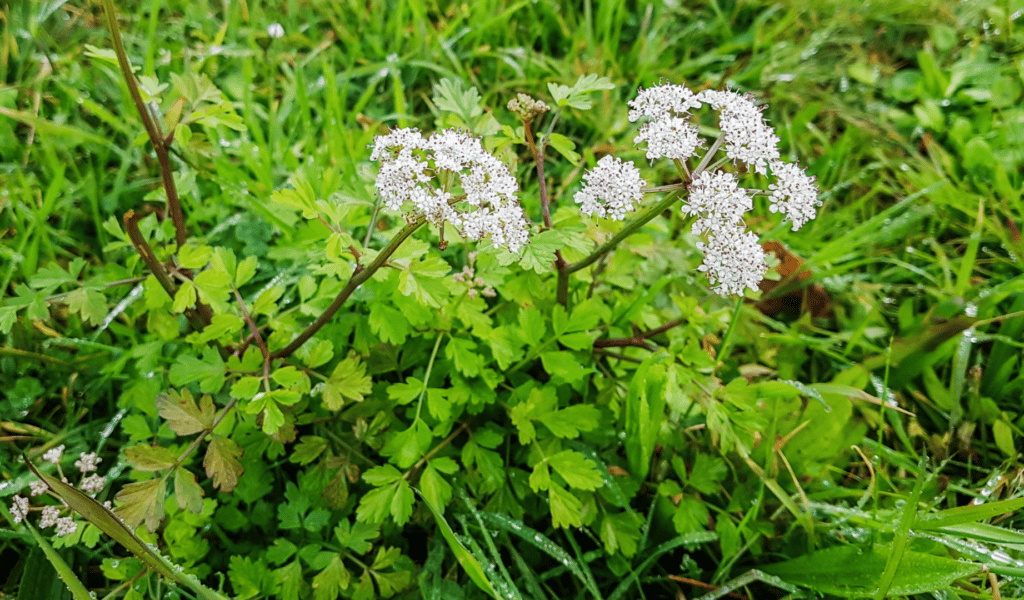
Hemlock Water Dropwort (oenanthe crocata)
Hemlock water dropwort is a perennial plant found in damp meadows, rivers and near lakes. It has a dome umbel with 15 to 35 rays ending in small balls of tiny white flowers which bloom in June and July. The leaves are triangular and lobed and taper down to a point. The stem is green and hollow and has multiple parsnip-like roots.
Why is it dangerous?
The entire plant and especially the root are extremely poisonous. It contains a toxin called cicutoxin which is an unsaturated alcohol that acts as a stimulus to the nervous system. Signs are not often seen due to the level of toxicity of the plant. It usually kills very quickly.
What are the signs of poisoning?
- Seizures which increase in intensity
- Muscle twitching, especially around the face, nose and ears
- Teeth grinding
What treatment options are there?
Although there is no cure, with quick diagnosis a horse can survive poisoning by dropwort hemlock. The vet must be contacted as soon as possible. The vet will empty the stomach contents and provide respiratory support. If a horse survives 8 hours after the initial poisoning, they are likely to recover.
How can I keep hemlock water dropout under control or prevent poisoning?
Using gloves and a ragwort fork, pull out the entirety of the plant to prevent poisoning.
Downloadable Information
Download a printable copy of this page to keep or share.
Downloadable VersionOur Work at The Mare and Foal Sanctuary
Advice and Resources
Lifelong Sanctuary
Rehoming



